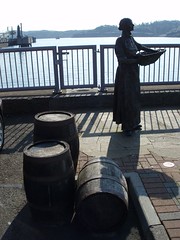In the late 19th and early 20th century, the herring industry was a cornerstone of the island economy, here in Lewis. The same applied up and down the coasts of the United Kingdom as a whole. In my transcription of the findings of the Napier Commission, I came across the testimony of a fish-curer from Burghead, on the east coast of Scotland. Thomas Jenkins had been plying his trade at Castlebay, Barra, for 13 years when he was quizzed by Lord Napier and his commission. It makes faintly sad reading to see the earnest and detailed outlining of the problems afflicting the herring trade in 1883 - and knowing that within a hundred years, there would be hardly any herring left. The only tangible memory of the herring trade in the Western Isles is in the statues of the herring girls along the harbour front in Stornoway, as shown on the left.
In the early years of the 20th century, young women would flock to the fishing ports of the UK to gut herring at a rate of 60 a minute, packing them into barrels, with copious amounts of salt. The barrels would go as far afield as Russia, where they were considered a delicacy by the ruling classes. Like the herringtrade, the ruling classes in Russia would be swept away within fifty years.

No comments:
Post a Comment